Background #
Multidimensional Data #
- Flat relational tables
- Multimedia feature vectors
- Data warehouse data
- Spatial data
- Text documents
Attribute Types #
- Attributes of multidimensional tuples may have variable types
- Ordinal (e.g., age, salary)
- Nominal categorical values (e.g., color, religion)
- Binary (e.g., gender, owns_property)
- Basic queries: range, NN, similarity
Basic Queries #
- (Range) selection query
- Returns the records that qualify a (multidimensional) range predicate
- Example:
- Return the employees of age between 45 and 50 and salary above $100,000
- Distance (similarity) query
- Returns the records that are within a distance from a reference record.
- Example:
- Find images with feature vectors of Euclidean distance at most ε with the feature vector of a given image
- Nearest neighbor (similarity) query
- Replaces distance bound by ranking predicate
Top-k Search Methods #
- Rank aggregation
- Index-based methods
Top-k Query #
- Given a set of objects (e.g., relational tuples),
- Returns the k objects with the highest combined score, based on an aggregate function f.
- Example:
- Relational table containing information about restaurants, with attributes(e.g. price, quality, location)
- f: sum(-price, quality, -dist(location,my_hotel))
- attribute value ranges are usually normalized
- E.g., all values in a (0,1) range
- otherwise some attribute may be favored in f
Top-k Query Variants #
Apply on single table, or ranked lists of tuples ordered by individual attributes
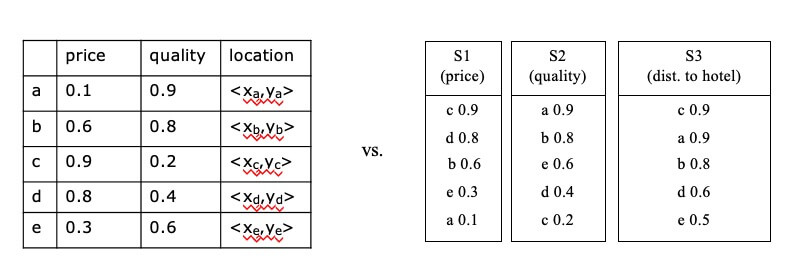
Ranked inputs in the same or different servers (centralized or distributed data)

Standalone query or operator in a more complex query plan
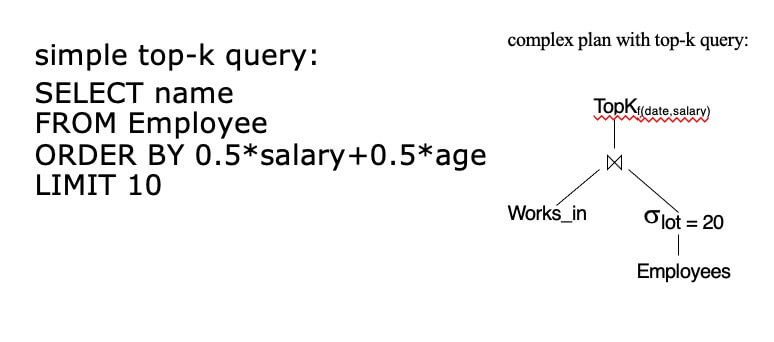
Incremental retrieval of objects with highest scores (k is not predefined)
Top-k joins
SELECT h.id, s.id
FROM House h School s
WHERE h.location=s.location
ORDER BY h.price + 10 ∗ s.tuition
LIMIT 5Probabilistic/approximate top-k retrieval
Random and/or sorted accesses at ranked inputs
Top-k Query Evaluation #
Most solutions assume distributive, monotone aggregate functions (e.g. f=sum)
- distributive: f(x,y,z,w)= f(f(x,y),f(z,w))
- e.g., A+B+C+D = (A+B) + (C+D)
- monotone: if x<y and z<w, then f(x,z)<f(y,w)
- distributive: f(x,y,z,w)= f(f(x,y),f(z,w))
Solutions based on 1-D ordering and merging sorted lists (rank aggregation)
Solutions based on multidimensional indexing
Rank Aggregation #
- Solutions based on 1-D ordering and merging sorted lists (rank aggregation)
- Assume that there is a total ranking of theobjects for each attribute that can be used in top-k queries
- These sorted inputs can be accessed sequentially and/or by random accesses
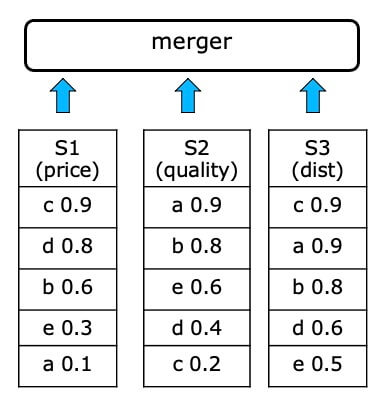
Advantages and Drawbacks #
- Advantages:
- can be applied on any subset of inputs (arbitrary subspace)
- appropriate for distributed data
- appropriate for top-k joins
- easy to understand and implement
- Drawbacks:
- slower than index-based methods
- require inputs to be sorted
TA: Threshold Algorithm #
Introduction #
- Iteratively retrieves objects and their atomic scores from the ranked inputs in a round-robin fashion.
- For each encountered object x, perform random accesses to the inputs where x has not been seen.
- Maintain top-k objects seen so far.
- T = f($l_1$, . . . , $l_m$) is the score derived when applying the aggregation function to the last atomic scores seen at each input. If the score of the k-th object is no smaller than T, terminate.
Example of TA(k=1,f=sum) #
- STEP 1
- top-1 is c, with score 2.0
- T=sum(0.9,0.9,0.9)=2.7
- T>top-1, we proceed to another round of accesses
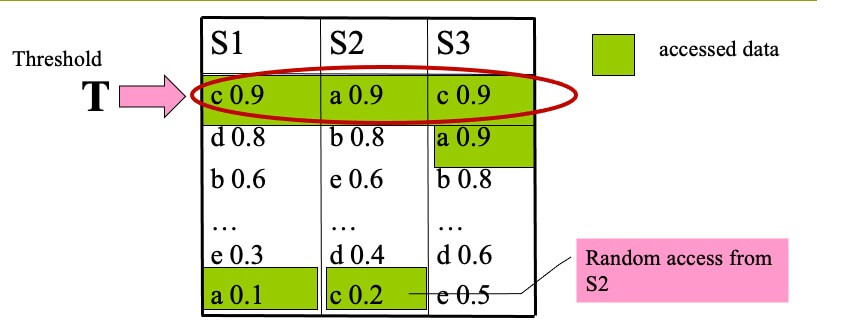
- STEP 2
- top-1 is b, with score 2.2
- T=sum(0.8,0.8,0.9)=2.5
- T>top-1, we proceed to another round of accesses

- STEP 3
- top-1 is b, with score 2.2
- T=sum(0.6,0.6,0.8)=2.0
- T≤top-1, terminate and output (b,2.2)

Properties of TA #
- Used as a standard module for merging ranked lists in many applications
- Usually finds the result quickly
- Depends on random accesses, which can be expensive
- random accesses are impossible in some cases
- e.g., an API allows to access objects incrementally by ranking score, but does not provide the score of a given object
NRA: No Random Accesses #
Introduction #
- Iteratively retrieves objects and their atomic scores from the ranked inputs in a round-robin fashion.
- For each object x seen so far at any input maintain:
- f_x_ub: upper bound for x’s aggregate score (f_x)
- f_x_lb: lower bound for x’s aggregate score (f_x)
- W_k = k objects with the largest f^lb.
- If the smallest f^lb in W_k is at least the largest f_x_ub of any object x not in W_k, then terminate and report W_k as top-k result.
Example of NRA(k=1,f=sum) #
- STEP 1
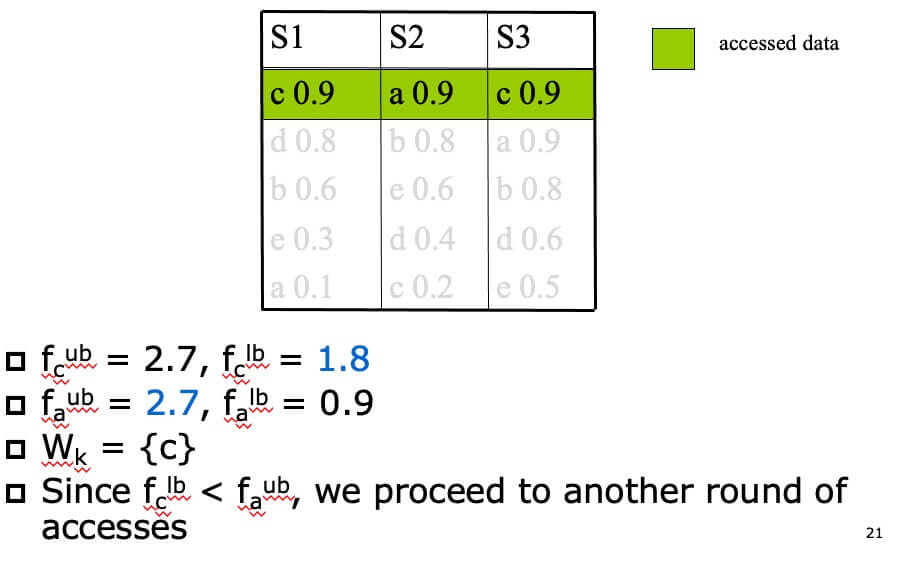
- STEP 2
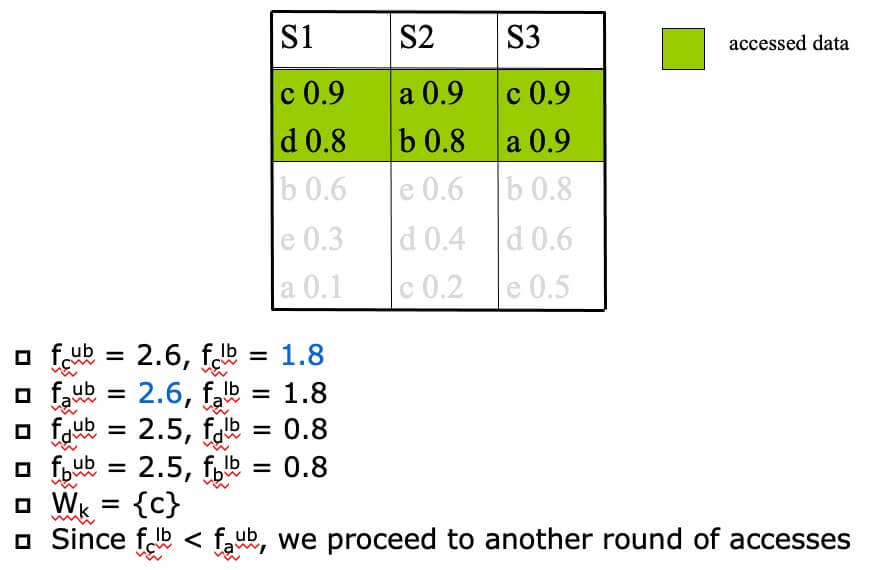
- STEP 3
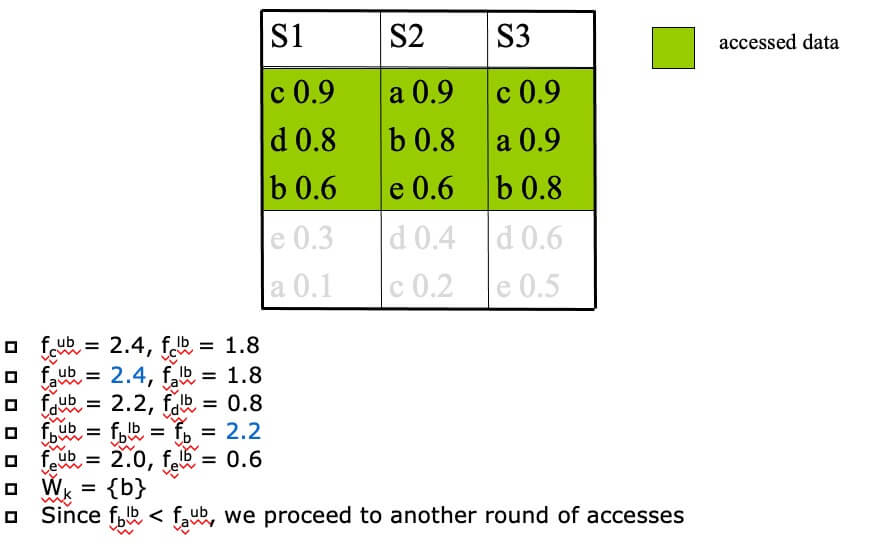
- STEP 4
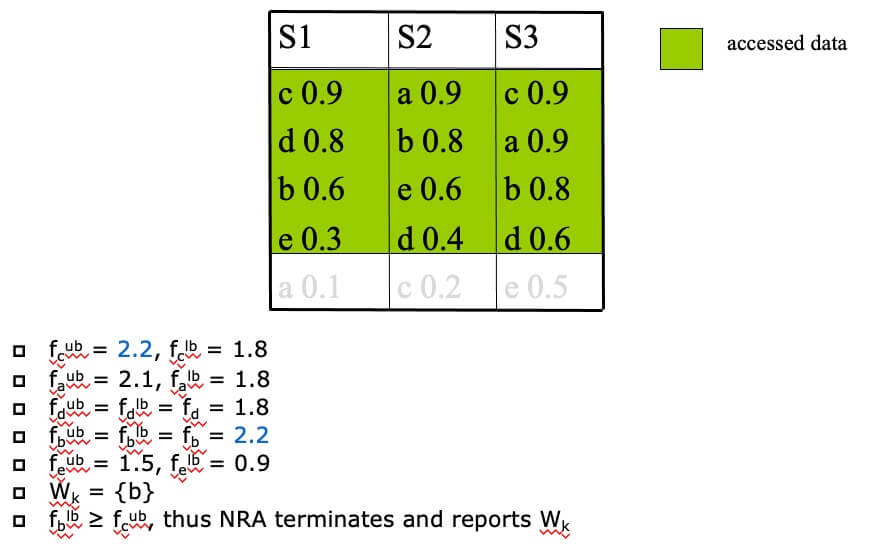
NRA Properties #
- More generic than TA, since it does not depend on random accesses
- Can be cheaper than TA, if random accesses are very expensive
- NRA accesses objects sequentially from all inputs and updates the upper bounds for all objects seen so far unconditionally.
- Cost: O(n) per access (the expected distinct number of objects accessed so far is O(n))
- No input list is pruned until the algorithm terminates
LARA: LAttice-based Rank Aggregation #
- LARA: An efficient NRA implementation
- Based on 3 observations about the top-k candidates
- Operates differently in the two (growing, shrinking) phases
- Takes its name from the lattice used in the shrinking phase
- Extendable to various top-k query variants